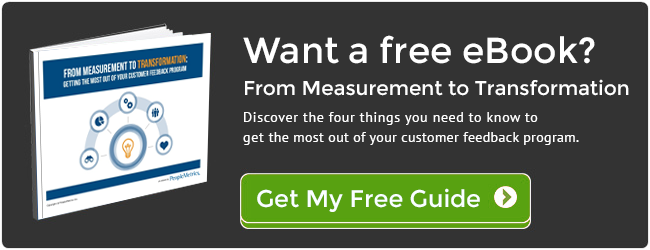Today, in the Age of the Customer, more and more businesses are asking their customers for feedback, and the methods are myriad: phone, text, website pop-ups, emails, messaging on the footer of receipts. Some are cheaper than others, but none of them are free. Marketing and marketing-related tasks are always scrutinized by budget-makers because the ROI is often elusive. And customer feedback programs are no exception. But, what if you could show that asking for feedback, in and of itself, leads to higher levels of engagement which in turn leads to higher spend?
Demonstrating ROI in Dollars
When we try to show ROI from customer feedback programs using every CEO’s favorite metric ($$$), we usually cite the correlation between customer Engagement or NPS and spend among customer groups: share of wallet is higher among Promoters versus Detractors, or the number of visits/purchases per year is higher for Engaged versus Disengaged customers.
But over time, we started to pose a hypothesis within that link that we wanted to test: what if the program itself is helping create these high-spending customers rather than simply identifying or describing them?
We have found that the best test for a causal link requires the same individual to share feedback on multiple occasions across a period of time. In this way, we can look at feedback provided in month 1 by a single individual and compare this to his/her feedback in, say, month 6. We then aggregate these changes and determine if there is a net increase or decrease in Engagement.
We have been able to test this theory recently using data from several of our B2B clients, and what we found was compelling evidence that repeat survey takers become more engaged over time. We saw an increase! Specifically, customers who were disengaged at Time 1 became engaged, and engaged customers at Time 1 became even more engaged. Across all studies we have seen a generally favorable movement across the period of time during which repeat feedback was shared.
And perhaps most importantly for the budget owners in your organization, spend moved with Engagement in this repeat-feedback-provider group as well.
With this analysis, we have been able to more definitively than ever before prove the ROI for a Voice of the Customer program.
So that's all great, but why does it happen?
So let’s talk about what is happening to the customers who are asked to participate in these feedback programs. Why do they become more engaged as they give more feedback? What’s in it for them?
They get an opportunity to express themselves.
People want to share information: for proof we need to look no further than the boom in social media we’ve seen in recent years. We collectively send over 400 million tweets per day, and a recent valuation estimated a $10 billion Twitter IPO. The story of Facebook was made into an Oscar-winning movie. Further, it’s not just sharing any information, it’s better if it’s about ourselves. Scientists using fMRI brain scans say that talking about oneself activates the same pleasure centers as food and sex. Social psychologists running studies on incentives show that, given the choice, people will accept smaller financial rewards for a task that involves talking if they are able to talk about themselves. Scientists, Wall Street, and David Fincher agree, the opportunity to express themselves is valuable to the customer.
They get a chance to get closer to people they rely on.
The invitation to share feedback sends a clear message that the organization values its relationship with you. It demonstrates commitment and an expectation of an ongoing relationship. A well-crafted survey results in a more intimate dialogue where customer-facing employees are exposed to constructive criticism and opportunities to improve. The resulting relationship with the customer is a closer one; authentic, genuine interactions are aspects of the engaged relationship that follows.
Finally, they get a tailored experience where the next interaction better meets their needs.
Feedback delivered quickly, processed quickly, and acted upon between visits helps refine the customer experience. In programs where the feedback is shared with the customer-facing team, there is a great opportunity to improve what is delivered to the customer - on an individual – and an aggregate basis.
It appears here we have both sides winning. While feedback program operators are happy to see the firm benefit, when we see the rising engagement among repeat-feedback providers, we are even happier to see that customers who repeatedly invest their time are enjoying the return of a more engaging customer experience.





%20(1).png)